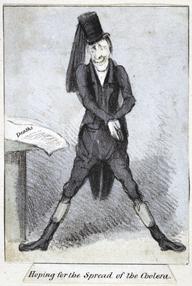

Drawing of Horley Table I, by Paul Drury. Drawing depicting patient on Horley Table, his arms behind his head and his legs spread and hoisted off the table by two straps. On either side of the patient are two plaster craftsmen, one in the left-hand foreground with his back to the viewer, one in the midground, bent over and focussing on his work. Both plasterers are wrapping the patient's legs, a loose bandage rests in a bowl in the foreground. Patient not looking at viewer. Additional strips of paper stuck to drawing to frame the edges, with graphite sketches to extend image and illegible inscriptions.
Paul Drury is best known as an accomplished etcher of portraits and landscapes. Part of the etching revival in the 1920s, Drury became head of the Etching Department at Goldsmiths from 1946 and President of the Royal Society of Painter-Etchers and Engravers from 1970. Relatively unknown, however, is his work during the Second World War at Queen Mary’s Hospital (QMH) Roehampton, which was founded in 1915 to cater to the huge numbers of amputee soldiers injured in the First World War.
Drury was posted to QMH as an assistant in the plaster workshop of the artificial limb unit in 1939, where he worked until the end of the war. Whilst there, he obtained permission from the War Artists Advisory Committee to make records of his experiences, producing a mix of finished and preparatory drawings, etchings, paintings and pastels that are represented in this collection of works. Through these, Drury captured the everyday activities of technicians, doctors and nursing staff alongside the wounded themselves, showing us a little of their personalities and emotions in portraits and group scenes. The works also introduce the wider experiences of convalescence at QMH during the war, including sheltering patients during air-raids, treatments for wounded limbs and the card games played to pass the time.
Details
- Category:
- Art
- Object Number:
- 2021-230
- Materials:
- ink
- Measurements:
-
overall: 319 mm x 248 mm
- type:
- drawing (image-making)




